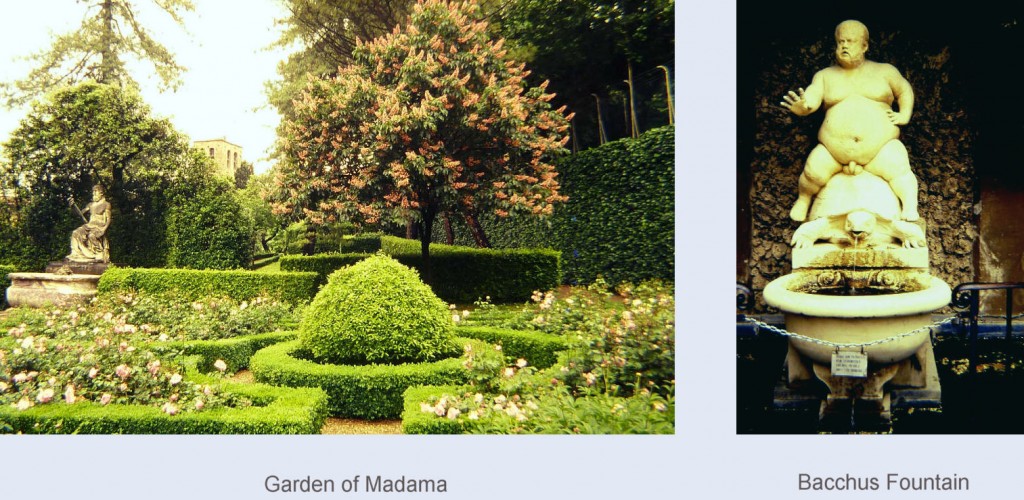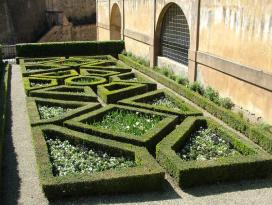Boboli Gardens
HISTORY OF THE BOBOLI GARDENS.
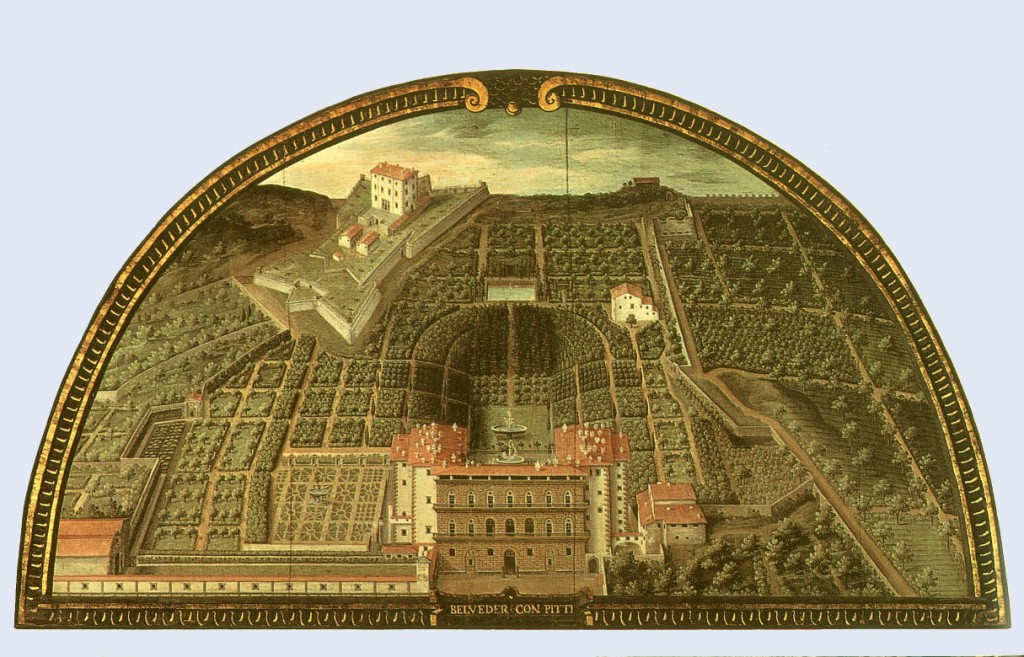
The "lunette" (shown above) was painted by the Flemish artist Justus Uttens when the Pitti Palace was owned by the Pitti family. The painting shows that the area of the future Boboli Gardens is largely covered by olive groves and ilex forests, with only one parterre garden to the left of the palace. The Belvedere, the white building on the skyline, was an arms store at the time the Boboli Gardens were created. Today it is an art gallery.
In 1549 land for the proposed gardens was purchased by the wealthy Duchess Eleonora, wife of Grand Duke Cosimo I of Tuscany. The Duchess moved with her family from the Palazzo Vecchio to the Pitti Palace where she wanted to create the most magnificent garden in Florence.
The name "Boboli" was a corruption of the name of "Borgholi" original the name of the owners of the land. The name stuck and the gardens are known as Boboli rather than Borgholi.
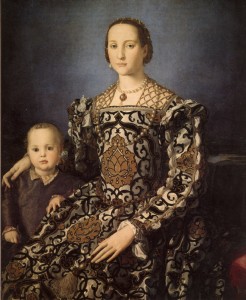
Duchess Eleonora and her son Giovanni
Duchess Eleonora employed Niccolo Tribolo as the architect and designer for her new gardens. Although Tribolo died soon after the work started, most of the gardens were laid out in accordance with his design. After Tribolo"s death Ammannati and Buontalenti continued the work in succession. Many of the garden sculptures were designed by the Mannarist sculptor Bacio Bandinelli.
It took workmen eight years to uproot the many olive groves and ilex forests and replace them with acres of gardens in the formal parterre style.
PRINCIPAL FEATURES.
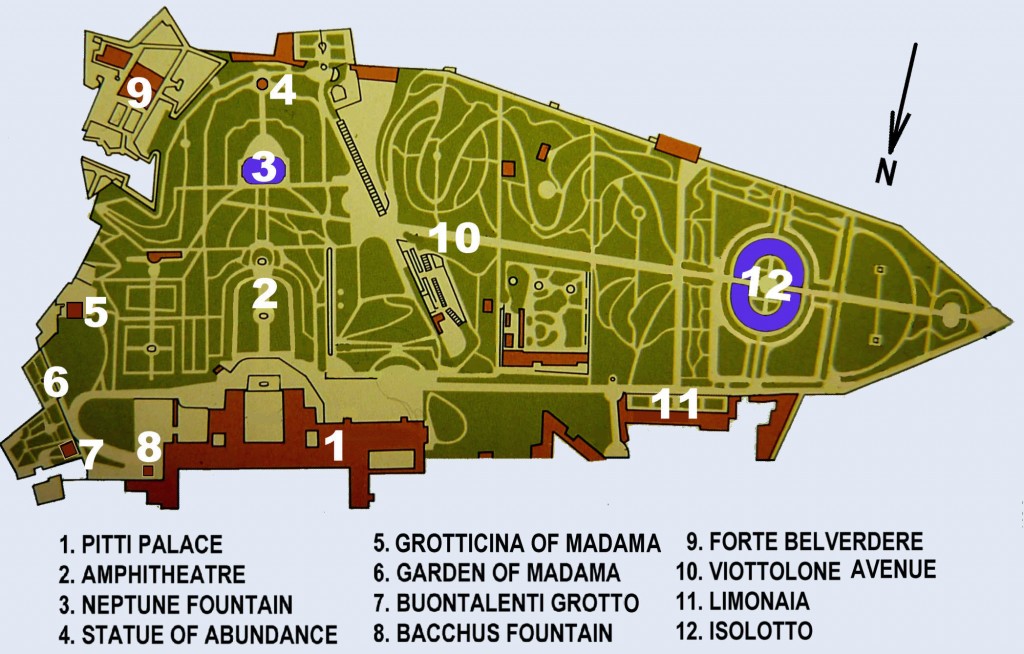
One of the earliest projects was the construction of the Grotticina di Madama. It was built between 1553 and 1555 by order of Duchess Eleonora. The grotto is populated by mysterious stone creatures, including a carved mountain goat, representing the Duchess"s coat of arms. Streams of water run down the walls of pumice stone, which have became covered by moss. Duchess Eleonora and her ladies often spent time inside the grotto to escape from the summer heat.
Valerio Cioli designed the "Bacchus Fountain", including a statue of the dwarf Morgante. It is one of the most delightful statues in the Boboli Gardens. Cosimo I's dwarf jester was the model for Bacchus, the Roman god of wine, seated astride a gigantic turtle. The fountain was completed in 1560.
Duchess Eleonora died in 1562, well before the gardens were completed. Her husband, Duke Cosimo I, ordered the planting of a number of dwarf fruit trees in what he named the Garden of Madama in her memory. It is a typical parterre garden where roses grow in beds surrounded by low hedges.
The Garden of Madama is one of the few parterres still remaining in the Boboli Gardens. Today most of the elaborate parterre gardens have been replaced by lawns and winding pathways, which require less maintenance.
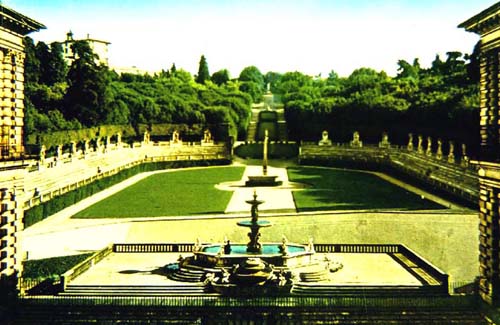
View of the Grand Amphitheatre
The brilliant architect, Bartolomeo Ammannati, designed a large amphitheatre and supervised its construction between 1560 and 1569. The amphitheatre was built on the site of the quarry that had supplied the building stone for the Pitti Palace. Ammannati also designed many of the garden fountains.
In the Grand Amphitheatre the wedding reception of Duke Ferdinando de' Medici to Duchess Christine of Lorraine was celebrated in 1589. A gigantic statue had been erected for the occasion and the guests were extravagantly entertained. The celebrations included a performance of the world"s first opera, tittled Daphne, but the musical score of the opera has not survived.
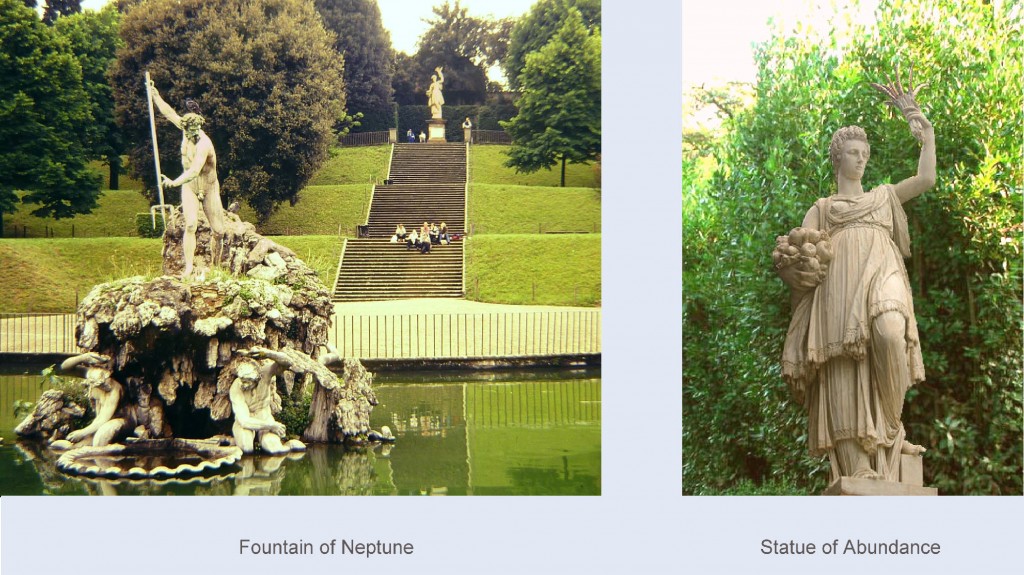
The statue of Neptune, by Stoldo Lorenzi, stands in the middle of a fountain to the south of the amphitheatre. Higher up the hill is the statue of Abundance, which was partly sculptured by Giambologna and completed by Pietro Tacca.
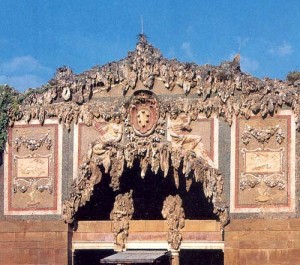
Detail of the facade of Buontalenti's Grotto
Bernardo Buontalenti, who succeeded Ammannati, created a fantastic grotto (referred to as "Buontalenti"s Grotto"). After completion of the grotto in 1593, Michelangelo's masterworks Quattro Prigioni (The Four Prisoners) were placed inside it. In resent years the sculptures have been replaced by copies” two of the originals are on display in the Galleria Dell' Accademia while the other two are in the Louvre in Paris.
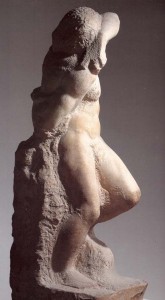
One of the 'Quattro Prigioni'.
The Quattro Prigioni, which depict muscular figures struggling to free themselves from the stone, had originally been presented in 1564 to Grand Duke Cosimo by Michelangelo's cousin and thirty years later placed inside Buontalenti"s Grotto.
A large limonaia was added as a winter storage for the enormous terracotta pots containing lemon and orange trees. Some of these pots were considered works of art in their own right and signed by the craftsmen potters who had created them.
In the 17th century the Viottolone, a long avenue lined with trees and marble statues, was created. To preserve the original statues, those along the Viottolone have now been replaced with copies.
Close to the Pitti Palace a large pit was dug to house Duke Fernando II di Medici"s menagerie of wild animals. The small zoo included bears, lions and tigers. The animals were fed by ducal servants with joints of meat to amuse the Duke"s guests.
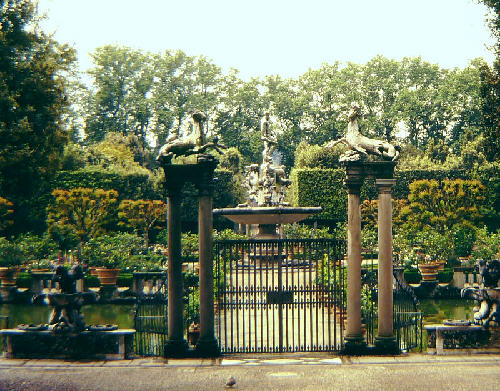
Entrance gate to the 'Isolotto'.
THE ISOLOTTO or LITTLE ISLAND is a romantic area, specially designed for private recreation. It is surrounded by a water garden, lemon trees in large terracotta pots and sculptures. The area was part of the 17th century additions to the Bobili Gardens, designed by Alfonso Parigi, and was inspired by Emperor Hadrian"s garden at Tivoli near Rome.
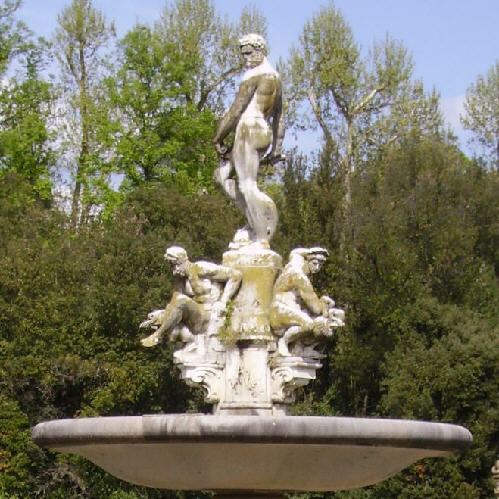
Ocean Fountain on Isolotto
Giambologna's Ocean Fountain, designed in 1576, is located in the centre of the island. Statues of Andromeda and Perseus stand in the middle of the moat, their image reflecting in the water. Andromeda is chained to a rock in punishment from the Gods, because her mother had boasted she was more beautiful than any Goddess. She was saved from death by gallant young Perseus, mounted on his famous winged horse Pegasus. As a reward Perseus married Andromeda.
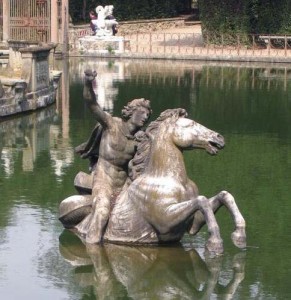
Persues on his winged horse
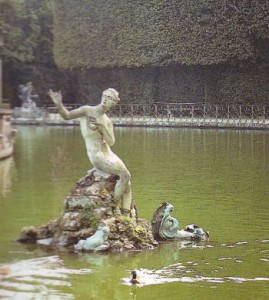
Andromeda chained to a rock
The sheltered area around the Isolotto was the favourite place of Henry James whenever the famous American novelist visited Florence. Henry James enjoyed sitting on a sun-warmed marble bench under a tall hedge. These marble benches are still in the gardens today and are used by visitors.
One of the earliest English descriptions of the Boboli Gardens was made in the 1640s by the famous diary-writer, John Evelyn. He wrote that the Boboli Gardens had hills, dales, rocks, grottoes, aviaries, fountains. Here is everything to make a paradise delightful. In the garden I saw a rose grafted onto an orange tree and much topiary work on the hedges.

